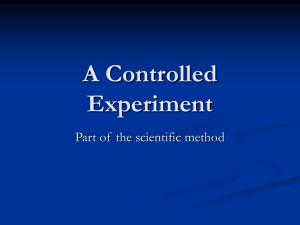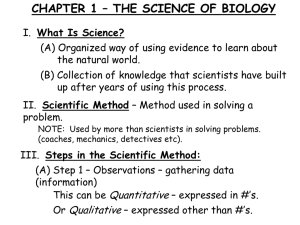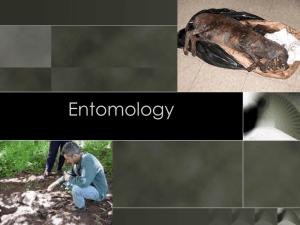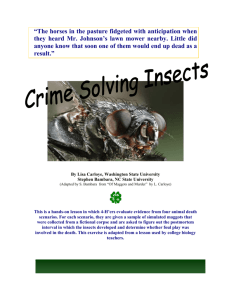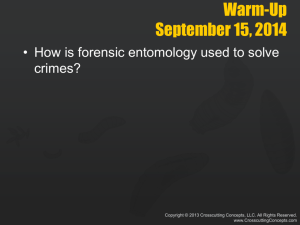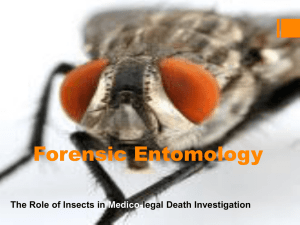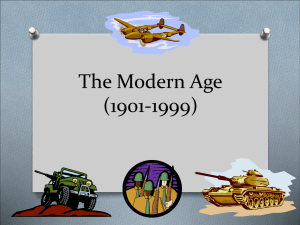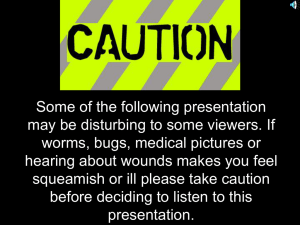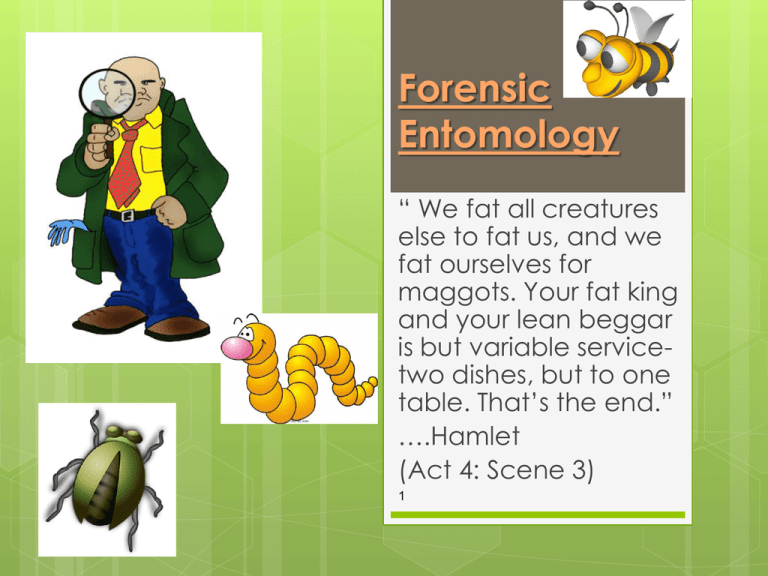
Forensic
Entomology
“ We fat all creatures
else to fat us, and we
fat ourselves for
maggots. Your fat king
and your lean beggar
is but variable servicetwo dishes, but to one
table. That’s the end.”
….Hamlet
(Act 4: Scene 3)
1
2
China 200 BC- Sung Tz’u
o
o
o
The death of Sung Tz’u, a
poor farmer in China,
represents the first time
insects were used in a
death investigation.
The investigator asked all
neighboring farmers to
bring their sickles (70-80)
Flies gathered at one
sickle due to the
presence of blood and
tissue remains. The man
was determined to be
guilty of the murder.
3
Forensic Entomology
Forensic Entomology has been used in all of the following:
Determine the time of death of a rotting corpse
Provide evidence in abuse cases: (Open wounds in
elderly)
Analyze “Spatter” evidence from insects walking through
blood.
Check for drugs, poisons (toxins will build up in the insects
feeding on a corpse)
Determine the identity of insects hidden in shipments of
products from other countries
Determine the types of insects that can cause crop
damage
Determine the types of insects that can be used as
biological controls in place of pesticides.
4
Flies: Order Diptera
o
o
o
Flies are usually the first insects
attracted to a dead body.
Their life cycle can provide
important clues: particularly for
time of death.
Life cycle of flies:
Egg
Larvae : 1st, 2nd, 3rd instars
Pupa
Adult
5
Finding a Carcass
o
o
Flies can detect
smell of
decomposition (as
little as a few parts
per million) by using
special hairs called
sensilla trichoidea
that are equipped
with chemical
receptors.
Flies must find
carcass early, before
it turns to mush
6
Egg Laying
o
o
o
o
Flies must lay eggs in
a moist area.
Clothing that sops
up blood and other
fluids.. becomes a
nursery for the eggs.
Females cannot
pierce skin.
Lay eggs in mucous
membranes of nose,
mouth, eyes, open
wound, scratches.
7
Egg Laying
A
female fly has
chemoreceptors on
soles of her 6 feet to
locate the proper
location to lay her
eggs.
Eggs are released
through the ovipositor
on the tip of her
abdomen.
A single female can
lay up to 400 eggs in
6 minutes
8
Maggots: Larva
o
Eggs will hatch
within10-24 hrs.
o
Maggots will
nurse on liquid
protein before
their mouth
hooks grow
large enough
to tear through
flesh.
9
Maggots
o
Larvae tear
at exposed
flesh with a
pair of tiny
mouth hooks
10
Mouth Parts of Maggots
As seen with an electron microscope
11
Maggots
Maggots
breath through
anal spiracles (butt
breathers)
These can be used to help
determine the larval
stage:
1st instar = 1 anal spiracle
2nd instar = 2 anal spiracles
3rd instar = 3 anal spiracles
12
The Feeding Mass
o
o
o
o
o
o
Maggots use collagen
splitting enzymes to break
through connective tissue
Larvae bury heads in flesh
The feeding mass generates a
lot of metabolic heat
The mass will periodically
move to the surface to cool.
Some insects will remove most
maggots by eating them.
This delays the decomposition
of the carcass
13
As
maggots grow, they
put on their own layer of
fat that eventually hides
all internal organs
except for the crop
(feeding tube) – seen as
dark red line extending
back from mouth
14
Pre-pupa Flies
Maggots
will stop feeding once they
reach the 3rd instar stage (about 1/2 inch
long)
They will then drop to ground, and seek
darkness; moving their light sensitive
heads right and left as they move.
15
Determining the Species
Determining the species of
maggot is difficult and
requires the third instar.
Often, forensic
entomologists will collect
half and grow the others in
lab to determine the
species after pupation.
If maggots not well
preserved: rely on simple
length of maggots:
compare to day to day
growth
16
Pupa
When ready to pupate,
maggots will bury
themselves in soil, or move
under leaves or carpets
They will contract into short,
thick plugs and wait for
larval skin to harden
They will then
metamorphosize into adults
New flies emerge within 1
week to 6 months later
(depending on
environmental conditions)
Pupa stages of the house fly
17
Emergence of Adult Flies
A
fleshy sac pops out of
slit above the eyes
The sac fills with fluid
and presses against the
top of the pupal case
The case pops open
along a fracture line
The adult fly will fully
emerge within thirty
minutes
Blow fly emerging (as seen with
an electron microscope)
18
Typical infestation:
o
o
o
First to arrive are
usually blow
flies: aka bottle
flies
They will appear
within a few
minutes
They have shiny,
metallic colors
19
Flesh flies
o
o
Flesh flies will be
attracted to the
site within a day
or two.
They are
recognized by
their large red
eyes.
20
Rove beetles and Soldier Flies
o
o
Rove beetles and
soldier flies will
appear once the
fly eggs have
hatched and
maggots are
present.
They will feed on
the developing
maggots
Rove Beetles
Soldier Fly
21
Cheese Skippers and Scuttle Flies
Cheese
Skippers and Scuttle Flies will
appear towards the end of the infestation
to feed on the fermented protein of the
later stages of decomposition
Cheese Skipper
Scuttle Fly
22
Mites, Moths and Spider Beetles
o
o
Mites show up very late in the infestation. They
prefer a dry cadaver
Clothes moths and spider beetles will be the last
to clean up the completely desiccated remains
Moth
Mites
Spider Beetle
23
Other Insects Commonly Scene Include:
Carcass beetle
Hide beetle
Carrion Beetle
24
Example of Post-Mortem
Interval (PMI)
8-14
hrs for
eggs to hatch
8-14 hrs to
finish 1st instar
2-3 days 2nd
instar
7-8 days- third
instar
Third instar of
Maggot
25
PMI
Converted to hours:
8-14 hours
8-14 hours
48-72 hrs
168-192 hrs
Totals to: 232 – 292 hrs
(this represents the total
time needed to reach
3rd instar)
In days: 9.6-12.2 days
26
PMI estimates
o PMI
estimates are
affected by:
Temperature
Time of day
Time of year
Exposure
27
Rate of development of
immature blow flies vs
temperature
Cooler weatherchoose later range
of 12 days; insects
develop slower
Warmer weather –
pick early part of
range, 9 days;
insects will develop
faster
28
Jobs at the scene
The following information
should be documented or
collected at the scene:
1.
Observations and
notes
2.
Climatological data
3.
Specimens from the
body
4.
Specimens from near
the body
5.
Specimens under and
near the body after
the body is removed
29
Observations
What
is the setting:
rural, urban,
aquatic
Estimate # and
kind of flying and
crawling insects
visible and
already present
Which types
appear to be the
cause of the
major infestations
of the body
30
Observations
What
is the compass
direction that the
body is facing?
Is the body in sunlight
or shade?
What is the position of
body?
Take photos
31
Climatological data
The
following
temperatures should be
documented at the
scene:
Ambient temp
Ground temp
Body surface temp
Under body temp
Maggot mass temp
Soil temp after body
removed
32
Climatological data
o
Once an approximate time frame is
established, it should be adjusted by gathering
additional weather data from local weather
stations
Maximum and minimum temperatures during
the presumed time period and amount of
precipitation should be traced back to the time
when the victim was last seen
33
Taking field samples
o
o
½ of the sample is
generally collected
and preserved in
alcohol (70-80%
solution of ethyl
alcohol)
The other ½ is kept
alive and raised to
adulthood in the
lab to help with
identification and
confirm timing.
34
Things you collect
Eggs,
larvae,
pupae, pupal
cases, cast larval
skins, feces,
feeding marks
Insect predators
including:
beetles, ants,
wasps, or insect
parasites
35
Insects Provide Other Clues
Insects
are also
used to show
movement of:
Victim
Suspect
Cars
Goods
36
“The Body Farm”
Dr. William Bass: University of Tennessee
37
Pig decomposition- 0 to 3 days
38
Pig 4- 10 days after death
39
Pig 10 to 20 days after death
40
Pig 20- 50- days after death
41
Dry decay 50- 365 days

